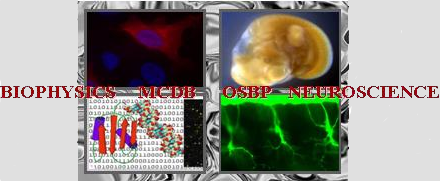Talk abstracts
Talk on Wednesday 09:45-10:00am submitted by Gianni Giarrano
Antibody fusion proteins containing domains from the tripartite motif family protein 72 (TRIM72) increase plasma membrane repair to treat muscle diseases
Gianni Giarrano (Ohio State Biochemistry Program ), Miguel Lopez Perez (Department of Physiology and Cell Biology, The Ohio State University ), Noah Weisleder (Department of Molecular and Cellular Biochemistry, University of Kentucky), Christoph Lepper (Department of Physiology and Cell Biology, The Ohio State University)
Abstract:
Plasma membrane repair is a highly conserved process that muscle cells use to maintain health under mechanical stress from contraction (1). Defective repair mechanisms exacerbate muscle diseases, including Duchenne/Becker muscular dystrophy and limb-girdle muscular dystrophy (2,3). The tripartite motif family protein 72 (TRIM72) is a required component of plasma membrane repair that facilitates vesicle fusion at injury sites by binding to the phospholipid phosphatidylserine (PS) (1). Our laboratory and others have shown that exogenous treatment with TRIM72 ameliorates the pathology of muscle diseases in preclinical models (3,4). However, the therapeutic potential of full-length TRIM72 in muscle diseases is limited by off-target effects, poor pharmacokinetic properties, and manufacturing difficulties (4). Here, we fused the fragment crystallizable (Fc) domain from the human IgG1 protein to a panel of TRIM72 truncations. This approach aims to increase protein half-life through endogenous antibody recycling machinery, simplify manufacturing through standard antibody purification, and decrease off-target effects using truncated versions of TRIM72. We expressed and purified multiple Fc-fusion proteins using antibody purification methods and found that they maintain PS biding activity. Laser ablation and dye exclusion assays in mouse myoblast cells revealed that Fc-fusion proteins significantly improved membrane repair upon intracellular overexpression or exogenous application. Exogenous treatment with Fc-fusion proteins also improved membrane repair in live muscle tissue isolated from a Duchenne muscular dystrophy mouse model. Additionally, subcutaneous injection experiments show that Fc-fusion proteins likely exhibit extended half-lives in vivo. Together, these results suggest that our novel Fc-fusion proteins address critical barriers impeding the clinical development of the full-length TRIM72 protein and represent a possible therapeutic approach for muscle diseases.
References:
1.Blazek, A.D., Paleo, B.J., & Weisleder, N. Plasma Membrane Repair: A Central Process for Maintaining Cellular Homeostasis. Physiology (Bethesda) 30, 438-448 (2015).
2.Paleo BJ, McElhanon KE, Bulgart HR, et al. Reduced Sarcolemmal Membrane Repair Exacerbates Striated Muscle Pathology in a Mouse Model of Duchenne Muscular Dystrophy. Cells. 11(9), 1417 (2022).
3.Gushchina, L. V. et al. Treatment with Recombinant Human MG53 Protein Increases Membrane Integrity in a Mouse Model of Limb Girdle Muscular Dystrophy 2B. Molecular Therapy 25, 2360–2371 (2017).
4.Weisleder N, et al. Recombinant MG53 protein modulates therapeutic cell membrane repair in treatment of muscular dystrophy. Sci Transl Med. 4, 139ra85 (2012).
Keywords: Plasma Membrane Repair, Muscular Dystrophy, Fc-fusion proteins
